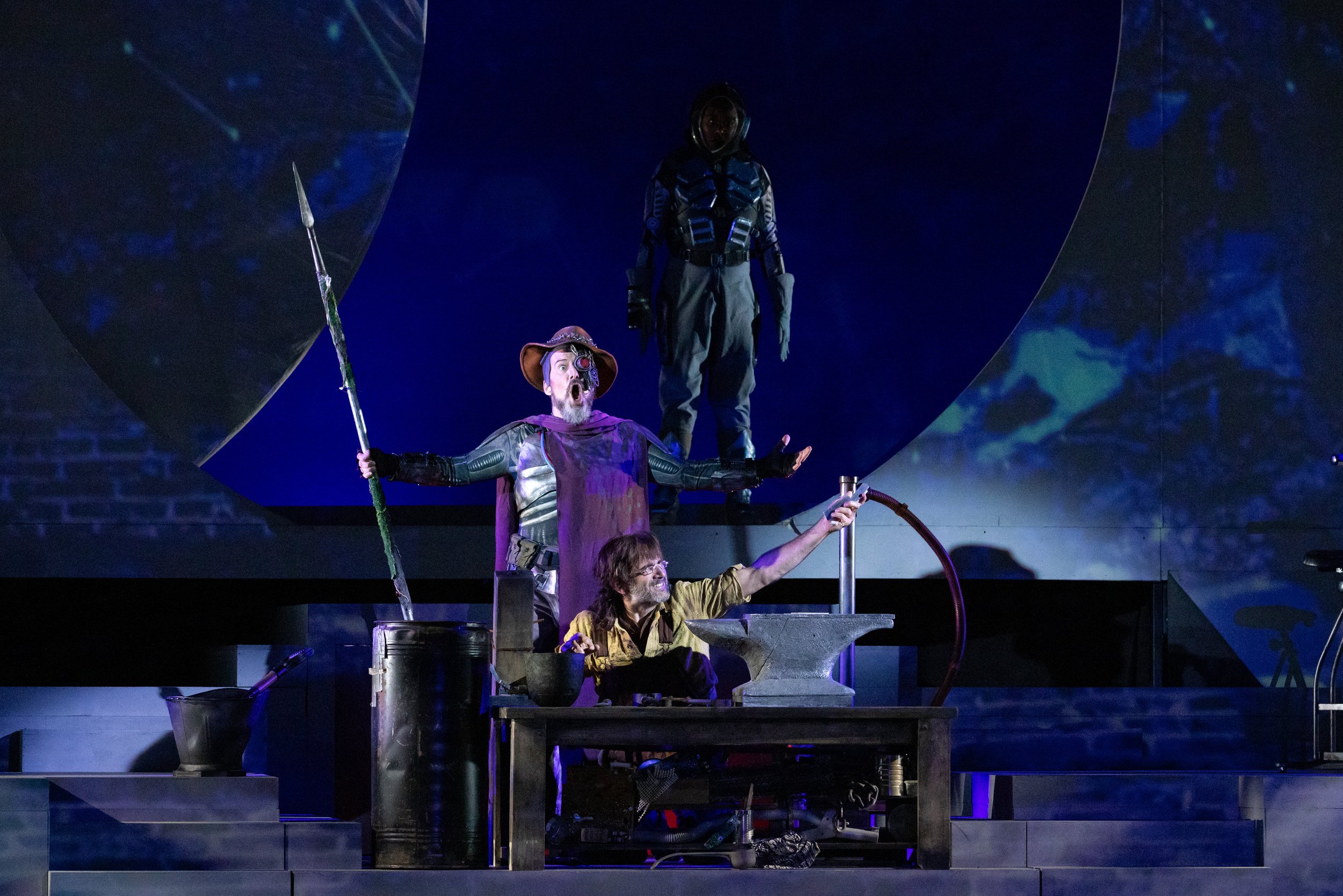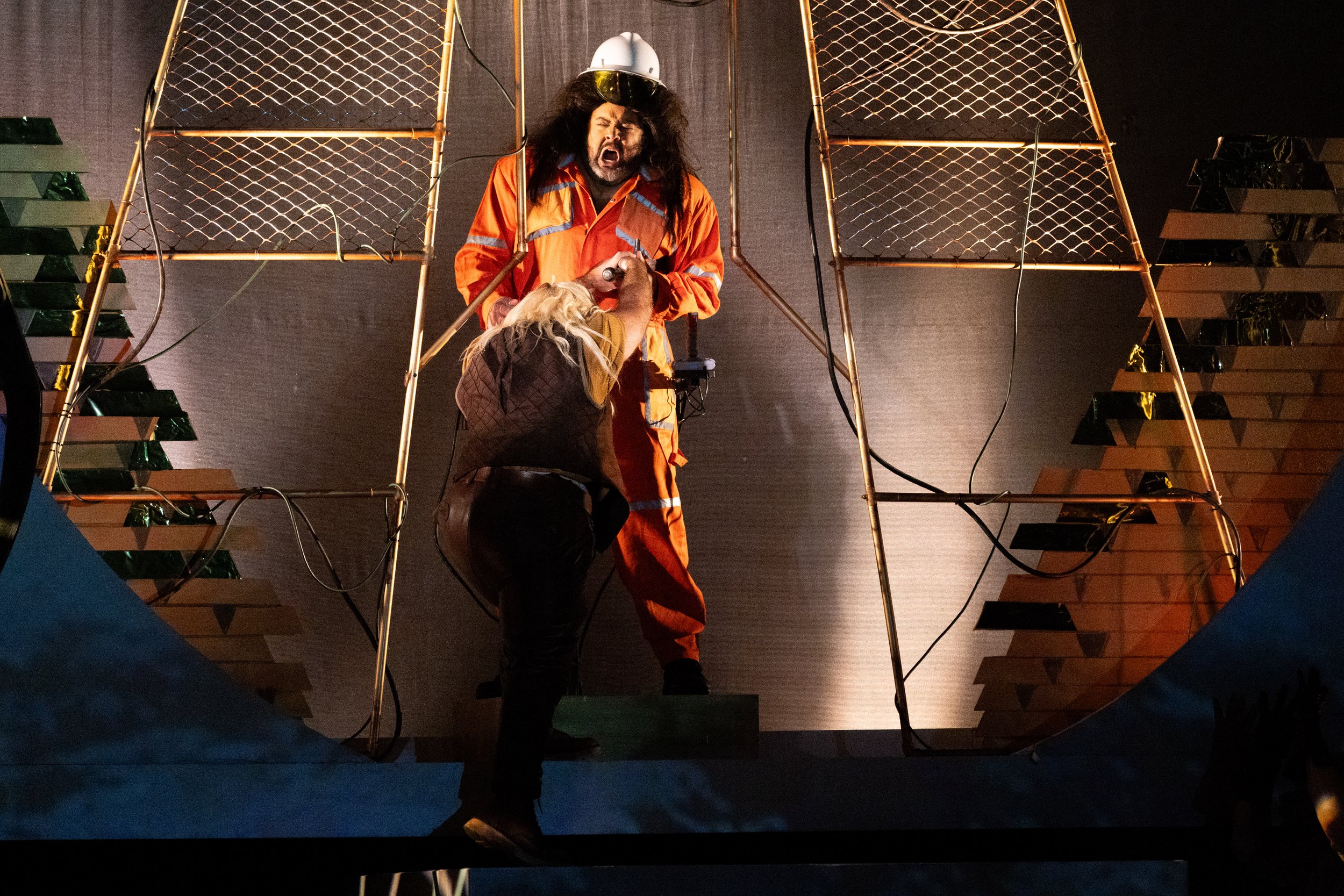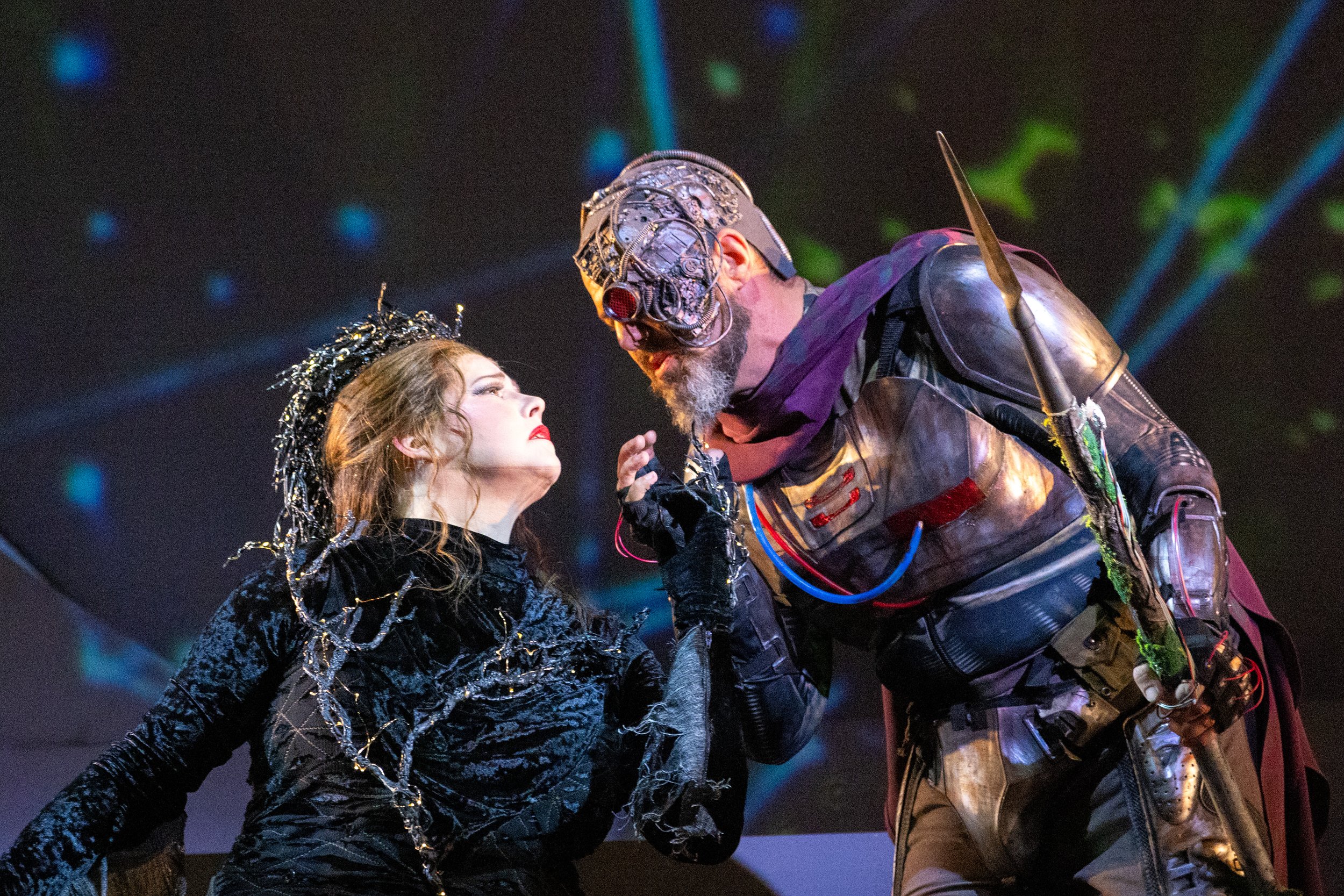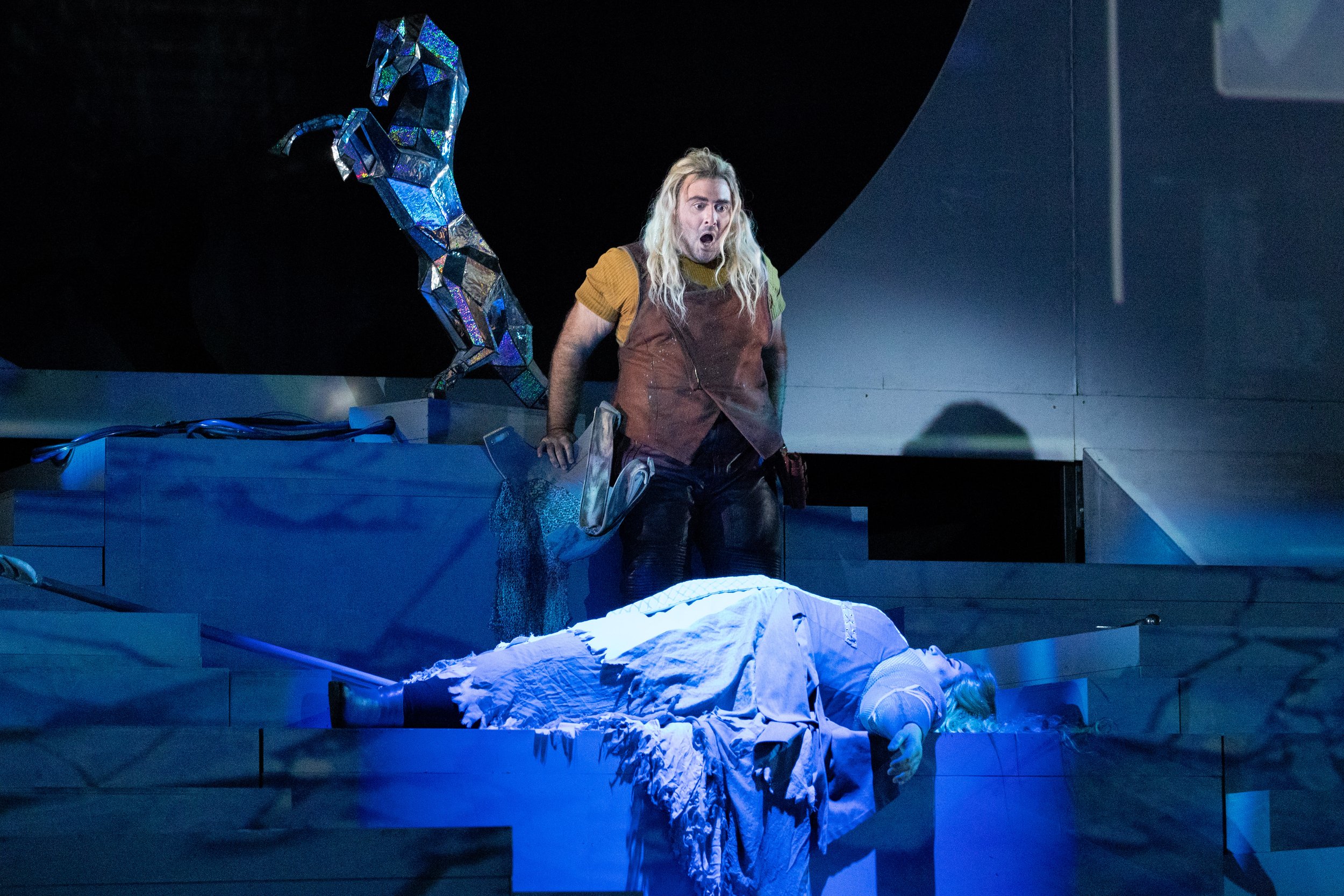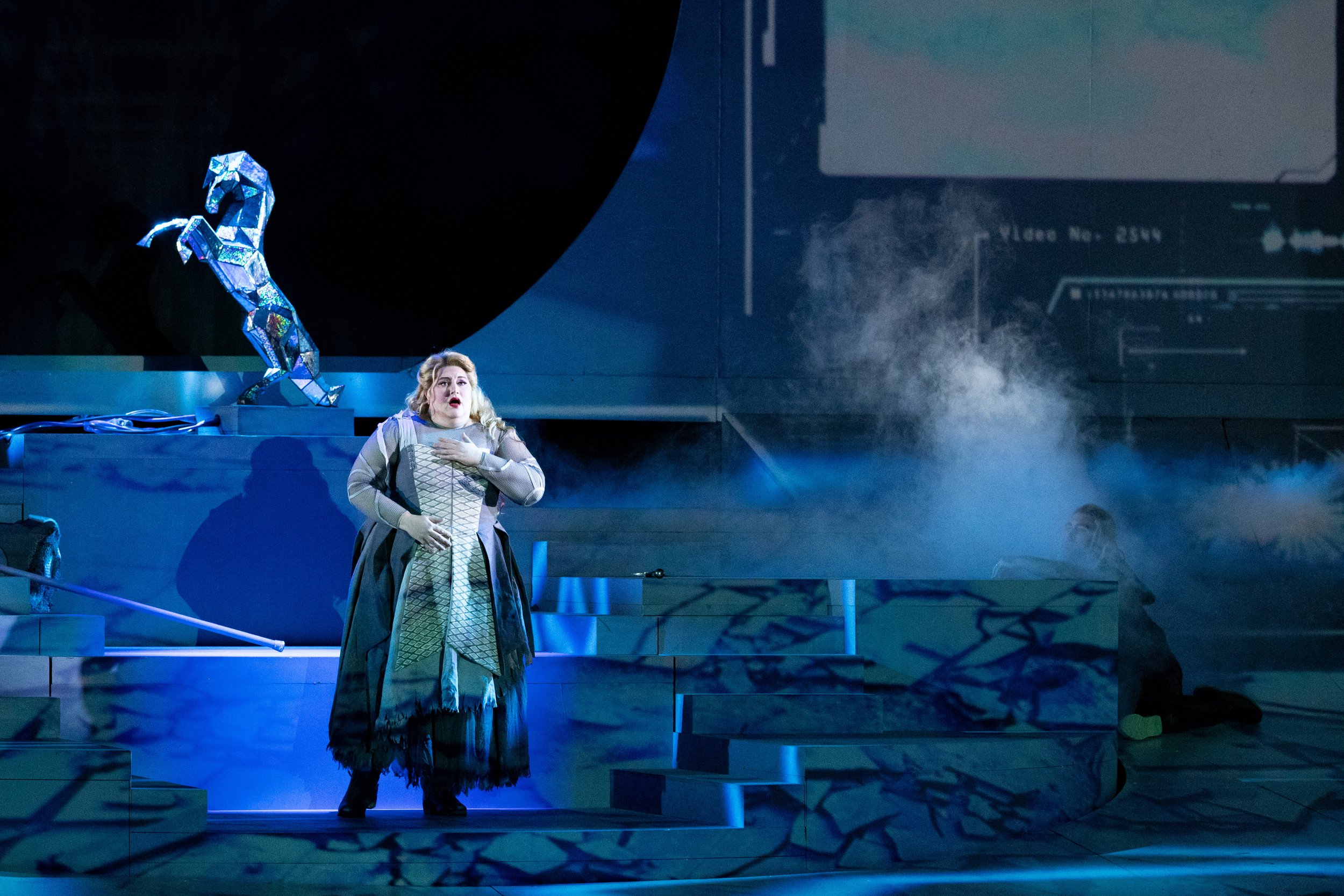Virginia Opera brought Siegfried to Fairfax Saturday night, after opening the week before in Norfolk. I am a huge fan of Richard Wagner’s Ring Cycle (Der Ring des Nibelungen), a tetralogy of operas that proceed in order The Rhinegold (Dad Rheingold), The Valkyrie (Die Walkũre), Siegfried (Siegfried), and The Twilight of the Gods (Götterdämmerung); I was greatly looking forward to episode three. Wagner wrote the libretto, largely based on Nordic legends, starting from the ending to the beginning, as each new episode led him to write a prequel and then composed the music from the beginning to the end; the process took 28 years. The Ring Cycle is a monumental, multilayered work that is an intriguing amalgam of political, social, moral, and philosophical issues encapsulated in stunning music, vocals, and storytelling. As has been substantiated and widely written about, Wagner the person was odorously flawed, but his music and operas were watershed events for those genres in the latter half of the nineteenth century.
l to r: Kyle Albertson as Wotan, Alissa Anderson as Erda, and Cooper Nolan as Siegfried. Photo by Dave Pearson Photography; courtesy of Virginia Opera.
VO is presenting the Jonathan Dove and Graham Vick abridged versions of the Ring in four succeeding years, having begun in 2021 with The Rhinegold. Siegfried is a hero in Norse mythology from the 12th century who did slay a dragon and later was impacted by the dragon’s blood and did fall in love with a beautiful woman, but in Wagner’s Siegfried, there is even more. Siegfried is the only hope of Wotan, the leader of the gods, to alter the path to destruction of the gods that Wotan himself has set in motion through his own corrupt instincts. The young Siegfried must first reforge a powerful sword to slay the dragon that possesses the magic gold ring which will allow its possessor to rule the world, then he discovers he must rescue Brünnhilde, Wotan’s disobedient daughter, whom he has placed asleep in the middle of a ring of fire; all of this is part of Wotan’s plot to accomplish what he cannot do himself. Just a simple fairy tale about the beginning and the end of the world, and the fatal flaws that brought it all down. I have read that Wagner was fascinated by Siegfried and meant this episode to be a comedy, at least in part. Personally, while there are a few funny moments, I have never been able to see it as a comedy, more later.
Cooper Nolan as Siegfried reforging the sword Nothung, and Matthew Peña as an excited, frightened Mime. Photo by Dave Pearson Photography; courtesy of Virginia Opera.
Clearly, the major highlight of Saturday evening’s performance at the George Mason University for the Center for the Performing Arts was the talented cast of singers giving strong and enjoyable performances across the board. The cast included tenor Cooper Nolan as Siegfried; tenor Matthew Peña as Mime, a Nibelung (a member of an underworld tribe) who reared Siegfried when his mother died; bass-baritone Kyle Albertson as Wotan, who he also played in the first two installments of VO’s Ring Cycle and in this version is disguised as the Wanderer; baritone Joshua Jeremiah as Alberich, the Nibelung who started it all by stealing the gold and fashioning the powerful ring; bass Ricardo Lugo as Fafner, the giant/dragon; contralto mezzo-soprano Alissa Anderson as Erda, Mother Earth and mother of Brünnhilde; soprano Alexandra Loutsion as Brünnhilde, a role she also portrayed in VO’s The Valkryie; and, soprano Alicia Russell Tagert as A Woodbird/robot, who sang warnings to Siegfried. Mr. Nolan, Mr. Peña, Ms. Anderson, and Ms. Tagert were in their first roles for Virginia Opera.
Kyle Albertson disguised as the Wanderer, standing, to quiz and warn Mime played by Matthew Peña, seated; the robot standing in the background holds Alicia Russell Tagert as A Woodbird. Photo by Dave Pearson Photography; courtesy of Virginia Opera.
There were three moments in their performances that I will long remember. The first was soprano Taggert lifting the visor in her robot suit and singing the role of The Bird. First, halfway through Siegfried, it was the first appearance of a female voice, and Ms. Tagert’s voice and singing was rapturous, a perfect fit, and a total delight. The next moment I will highlight, and my favorite of the night, was the scene where Wotan calls upon Erda for advice. The costumes and staging here were used to great effect, with bass-baritone Kyle Albertson being an excellent Wagnerian singer, and soprano Anderson matching his performance; I wish I could watch it again. Kudos to Scene and Costume Designer Court Watson. Finally, and in the final scene, Siegfried passes through the ring of fire and encounters the sleeping Brünnhilde, his first sight of a woman; he experiences fear for the first time – chew on that one for a while, well played and sung by Mr. Nolan. Then Ms. Loutsion as Brünnhilde awakens in a costume more befitting a lovely maiden than the warrior gear she had to wear in The Valkyrie. She is also an excellent Wagnerian singer and animates the scene explosively. Her thunderous welcoming of the sun woke me up and made me glad I was there. In general, the second act had less distraction and was beautifully done.
Cooper Nolan as Siegfried (foreground) slays the giant/dragon Fafner played by Richard Lugo. Photo by Dave Pearson Photography; courtesy of Virginia Opera.
The Virginia Symphony Opera and Conductor/Artistic Director Adam Turner are an outstanding combination. The score for Mr. Dove’s version of Siegfried is paired from the original’s four hours to a little less than three hours, and the chamber-sized orchestra employs less than half the musicians called for in the original. Conductor Turner says, however, that every note played was composed by Richard Wagner. In the first act, I felt the music seemed a tad thin and not entirely in sync with and supportive of the singers. However, that may be unfair; my response to the music was influenced by the difficulty I had with the staging in the first act, as I will next discuss. The music in the second act more than met my expectations. The intricate music was beautifully played and executed, another highlight of the opera for me.
Alissa Anderson as Erda and Kyle Albertson as Wotan. Photo by Dave Pearson Photography; courtesy of Virginia Opera.
Now let’s deal with the staging. The Ring touches on many important issues and stage directors typically narrow the focus of a production to a main one or two. Director Joachim Schamberger used a similar modernized symbolic approach to the staging of Siegfried that he employed for VO’s The Valkyrie about which I offered critical comments in my report on the distractions created by that staging. I applaud creative and innovative staging in general, but these did not work well for me. I listened as I always do to scholar in residence Joshua Borth’s “Let’s Talk Opera” episode online, this one covering Siegfried, and he admonished his audience to pay attention to what VO’s opera director was trying to accomplish. This is good advice, and I tried. I once defended Washington National Opera’s outstanding, modernized Ring Cycle in 2016 with this comment praising the innovations: “With Wagner, just get into the fantasy and leave the driving to the director. The truth will not appear on the surface, but it will seep into your bones and heart; you will be mystified, maybe even spell bound, but changed”. On the other hand, I recall disliking a Met Opera production of the Ring that was staged on a giant piano keyboard. Let me offer another reflection as part of my explanation for my discontent. I am fond of trying to solve the NY Times daily puzzle called Connections where you try to arrange 16 words into four groups of words each related by a theme. Recently, I tried to solve one of the groupings while watching a football game on television. I am proud to say I solved the puzzle. However, I was oblivious to the plays that led to a touchdown while I was working on the puzzle. Trying to understand Director Schamberger’s staging – what was the purpose of the robot and what was the robot doing, for example – made me less attentive to the music and singing and the flow of the storytelling. I welcome innovative stagings, but one hopes that all the elements of the opera will work together to enhance the audience’s experience of each element.
Cooper Nolan as Siegfried finds and awakens and falls in love with Brünnhilde portrayed by Alexandra Loutsion. Photo by Dave Pearson Photography; courtesy of Virginia Opera.
That said, the innovative approach to staging was interesting and did not prevent me from enjoying the opera, just made it more of a challenge than I wanted. Remember I said I had difficulty experiencing Siegfried as a comedy. The performance began with a large leaf (representing nature?) projected onto a large scrim that formed the backdrop for the stage. A circle opened in the leaf with red and then black smoke or liquid filling the circle, reminiscent of blood and the dark forces. Wotan appears in the circle breaking a limb from a tree, to fashion a spear – nature being violated to serve the interests of power and control. Nothing funny here. While I am critical of the staging, it should be said that Driscoll Otto’s work on the lighting and Mr. Schamberger’s projection work was excellent. The opening scene in Mime’s forge could be funny. Siegfried is an unruly, impulsive teenager type who creates difficulty for his caretaker Mime. However, Siegfried is portrayed as obnoxious and we know Mime is evil, using Siegfried as his tool to capture the ring for himself. Remember the scene in the first Indiana Jones film where Harrison Ford was in the room with snakes? That was funny because we liked him and knew he would survive the danger. Nothing lighthearted to me about this early scene in Siegfried that appears to be a contemporary of the film “Deliverance”. The air resistance bike seemed out of place; I guess that could be funny if this was cartoonish and so could the mini fridge with canned drinks, but this opera never seems to distinguish itself on this level. It goes on like this all the while with images moving onto and around the scrim to remind us, I suppose, of how AI has seeped into our lives. In the final scene, Brünnhilde has been placed in a high-tech chamber while she sleeps. It didn’t seem so at the time but that could be viewed as funny, but magic doesn’t need high tech to work and there is serious business afoot – the gods have to be destroyed.
Alexandra Loutsion as Brünnhilde, now in love with Siegfried embraces her new life and purpose. Photo by Dave Pearson Photography; courtesy of Virginia Opera.
I hope it is clear that I support VO’s forward thinking and its approach of reaching out to all of its fans in its programing choices. I also hope it is clear I recommend Virginia Opera’s Siegfried as an entertaining evening and a worthwhile artistic experience, despite my reservations with the staging, and I hope that my comments have piqued your interest and might be helpful to those readers who intend to take in a performance.
The Fan Experience – Siegfried was scheduled for performances in Norfolk on September 29, October 1; in Fairfax on October 7 and 8; and in Richmond October 13 and 15. The opera is sung in German with supertitles in English shown on an overhead screen; the performance lasts for a little less than 3 hours plus a 20 minute intermission. Tickets are available at this link. Virginia Opera intends to finish its Ring with a production of the final episode, Gotterdammerung, next season.
VO’s next production this season will be The Barber of Seville in Norfolk on November 3, 4 and Fairfax on 11, 12 and Richmond on 17, 19. See this link for details.
I recommend the pre-opera talk on Siegfried, given by Joshua Borths, Virginia Opera’s scholar in residence, which starts 45 minutes before the beginning of the opera. Get there early to get a good seat. If you can’t make a performance but want to know more about the opera, Mr. Borths covers the same material and more in his “Let’s Talk Opera” lecture available on Youtube.com; in fact, I recommend both. For a traditional audience attending an avant garde production, it might be helpful for Virginia Opera to go even further and point out with more detail in the program book what is going on with the symbolism in innovative productions, just a thought. I suspect that spending this much time thinking about the staging, I would enjoy it more if I saw it a second time.



